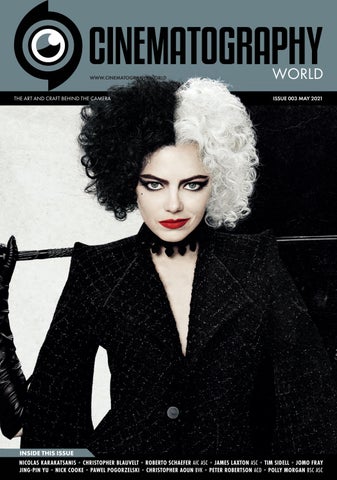
15 minute read
PETER ROBERTSON ACO GBCT ASSOCIATE BSC•SMOOTH OPERATORS
THE VENDOR’S VOICE
A look at the Production Equipment Rental Group - PERG
By Michael Goldman
In the opinion of camera industry veteran Harry Box, the primary purpose of a good trade association “is to identify areas where there is difficulty or problems that affect everyone and address them as a service to the whole industry.”
Box ought to know – he has served for over ten years as manager of the Production Equipment Rental Group (PERG) at ESTA (the Entertainment Services and Technology Association). Particularly considering challenges posed by the pandemicravaged last 12-plus months, Box suggests there are few entertainment sectors that need such support more than the equipment rental industry.
PERG evolved a little over a decade ago out of the former Professional Equipment Rental Association (PERA) – an independent trade organisation specifically for rental companies in the motion picture and television space. Eventually, PERA was absorbed into ESTA as one of several programmes that the association supervises.
“ESTA is an international trade association for all entertainment categories,” Box says. “Film and television is largely the same equipment manufacturers, a lot of the same standards, and a lot of the same interests as other entertainment sectors like event rigging, live concerts, theatre and more. That brought stability, and at that point we became a programme within ESTA known as PERG.”
Today, Box says PERG has about 90 member companies ranging from large players such as Panavision, ARRI, Keslow Camera and others to “all the premiere brands” and a wide range of smaller companies across the United States. “We include all kinds of companies, big and small, but the goal is the same – to figure out what kind of needs are universal to all of them?”
Along those lines, in terms of recent events, the organisation’s response to the Covid-19 pandemic serves as an example of addressing important needs impacting the equipment rental community. Box explains that the wider entertainment industry produced a template for production-related Covid protocols with the 2020 White Paper published by an industry-wide task force last summer, and there have been other solid efforts in various sectors. However, as Box puts it, “there needed to be a similar thing for vendors specifically.”
PERG therefore put together four specific working groups – one for sound stages, one for camera, one for lighting, and one for vehicles, since lots of rental companies own-and-operate vehicles. The organisation asked them to come up with vendor-oriented Covid protocols that would be compliant with CDC and OSHA guidelines.
“We had to take that [wider] guidance and interpret it,” Box relates. “How does it apply to equipment like lighting stands, lenses, cameras – all these different, delicate pieces of equipment made of all kinds of different materials? We came up with guidelines and released them last April as a public review document, got feedback, and finalised them last summer.”
The resulting document – PERG Safe Return To Work Guidelines –“was something the industry needed, and that’s always our focus,” he adds.
Long before the pandemic hit, however, PERG was working on events, papers, protocols and industry-wide dialogue on a wide range of issues that are of particular importance to equipment vendors – including, insurance challenges, rental software, theft prevention, and much more, sometimes in partnership with other important industry entities.
In particular, Box says, in recent years PERG got together with the Association Of Independent Commercial Producers (AICP) to address particular challenges that vendors run into when negotiating rental contracts with production companies and large studios.
“It’s a perennial problem that big studios, who have enough clout, will redline the contracts, not agreeing to certain things or demanding changes, which slows everything down,” he explains. “Principals and owners of companies spend hours and hours having to re-negotiate the same basic rental contract they previously used over and over again. Eventually around 2012, we formed a joint committee with AICP to try and come up with termsand-conditions on major, consistent points that rarely change, and we offered that as a resource to the industry.”
Box says that over time, with input from the insurance industry and direct contact with major production companies, among others, basic agreement on many points was achieved. “For example, production companies didn’t understand why it takes so long to produce a list of missing and damaged equipment after a job is returned,” he adds. “So camera rental industry pioneer, the late Denny Clairmont, brought them over and had them observe technicians going over equipment from a recent job, piece-by-piece. That’s how those companies understood why it takes more than two hours to produce a loss-and-damage report. By the end of that process, trust was there between the two sides, with give-and-take on both sides.”
As a result, the AICP-ESTA Terms & Conditions document was produced, which has essentially been making life a bit less complicated for rental companies ever since. Box says PERG has on its agenda the hope of next bringing the usefulness of this initiative to a wider clientele – the major studios.
PERG’s relationship with ESTA has also allowed the organisation to join its parent’s fraud-and-theft prevention programme, known as Rental Guard. That is essentially a five-year-old international network/ database for rental companies, whether or not they are part of PERG, to list missing or stolen equipment serial numbers and share information about how thefts are happening, and file reports on theft issues across the rental industry.
“Rental Guard has grown every year in terms of the number of people registering for it and using it,” Box says. “There has long been an international problem regarding theft. We have done lots of outreach to rental companies, labour guilds, and others to educate them about the nature of equipment theft in the modern era. And now, people are using Rental Guard as a tool to recover their equipment. It also serves as a deterrent because, if you have a website where people can look up serial numbers of stolen equipment, then all of a sudden, you have a limit in place, people are going to start being a lot more careful, and the theft marketplace becomes less free-flowing.”
Box points to other, newer issues on the horizon that PERG is also hoping to work with major studios on. Among them are DEI (diversity, equality, inclusion) challenges in the rental industry – the fact that in the US, there are not a large number of minority-owned rental companies. He says PERG “is working with studios right now to encourage actionable ways to address this issue going forward.”
But more broadly, at the end of the day, Box suggests that PERG’s greatest contribution may be in the area of communication and interaction across the rental industry.
“After all, our members want to talk to each other and learn from each other,” he says. Prior to the pandemic, four major yearly live events were routinely held across the US specifically for the purpose of bringing members together, and Box expects those to resume in some form once the Covid crisis abates.
“We would hold a major membership meeting, where members could discuss things like insurance, rental software, problems they have with clients and how they deal with those issues,” he explains. “We also started doing a breakfast at NAB and at Cine Gear, and we would host a New Yorkbased collaborative party with AICP, a really fun Oktoberfest party, and we were doing a similar Cinco de Mayo based event in Los Angeles. The idea was that bringing rental houses together with each other and with clients was a huge benefit to members.”
Although the pandemic took live events off the table over the course of the last year, Box adds that a silver lining has emerged in the sense that the organisation has realised remote communication technology can help connect members more frequently, both formally and informally, going forward.
“The PERG executive committee, made up of 12 member companies that are the steering council for everything we do, used to only meet four times a year, around the trade shows,” he says. “But that was hard, because everyone had to travel, and we had to book a space and then try to get everyone together for meetings while they were trying to cover the trade show. Now, we are doing one-hour meetings on a monthly basis via Zoom, and frankly, we are getting way more done, and everyone is more regularly engaged.”
PERG has also started holding remote one-hour “Coffee Break” events in which experts in some areas of interest, such as small business loans, labour law issues and mental health, for example, can give a talk to interested members via Zoom. And Box expects more such innovative remote programming to develop in the coming months.
“After all, this technology lets us get the membership together without them ever leaving their office,” he relates. “So that is something we will definitely be pursuing.”
Opposite: Camera prep at Daufenbach Camera (Chicago). Right: Check out at Koerner Camera (Portland, Oregon). Below: Reception before PERG’ General Membership Meeting at NAB, Las Vegas. Lower: Early COVID parking lot prep at Koerner Camera.
Photos: Wendy Davis, Daufenbach Camera. Meg Valliant, Koerner Camera Systems
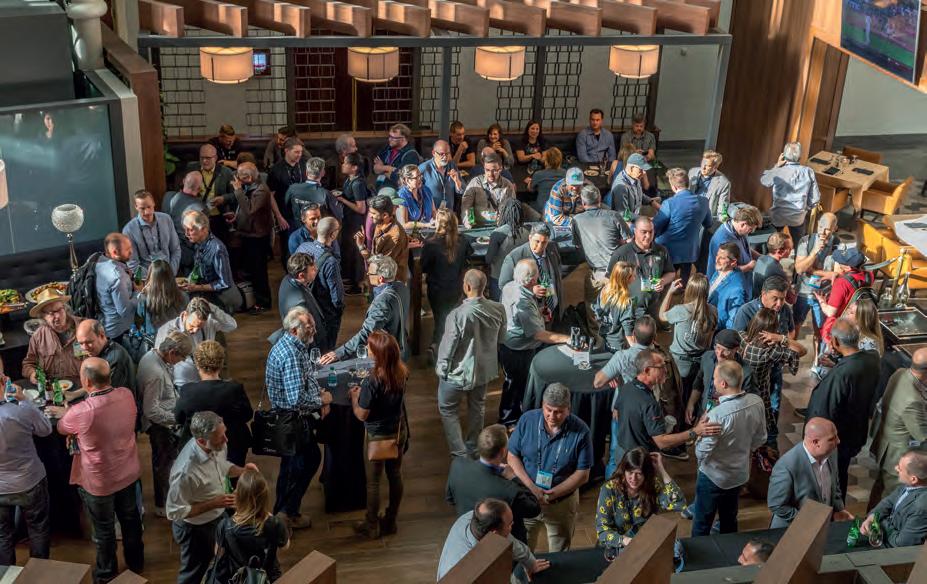
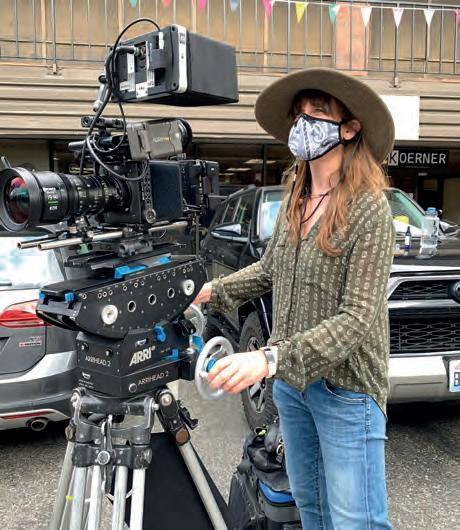
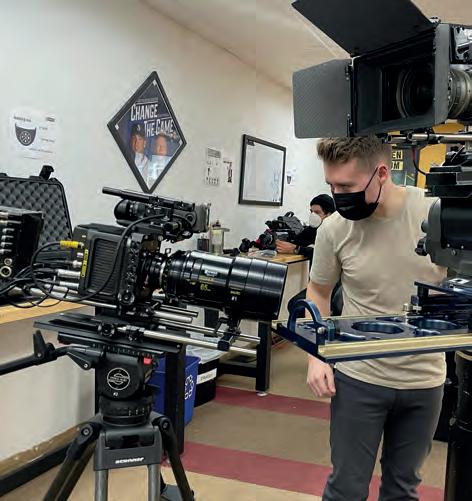
BEDAZZLED
By Michael Burns
ETC started making lighting fixtures in 1992 with the introduction of the Source Four, an ellipsoidal reflector spotlight that put out 40% more light than other fixtures, but used 40% less energy to do it. Nearly 30 years later, the company is a flourishing manufacturer of both lighting and rigging technology, and employs over 1,200 people across 14 corporate offices.
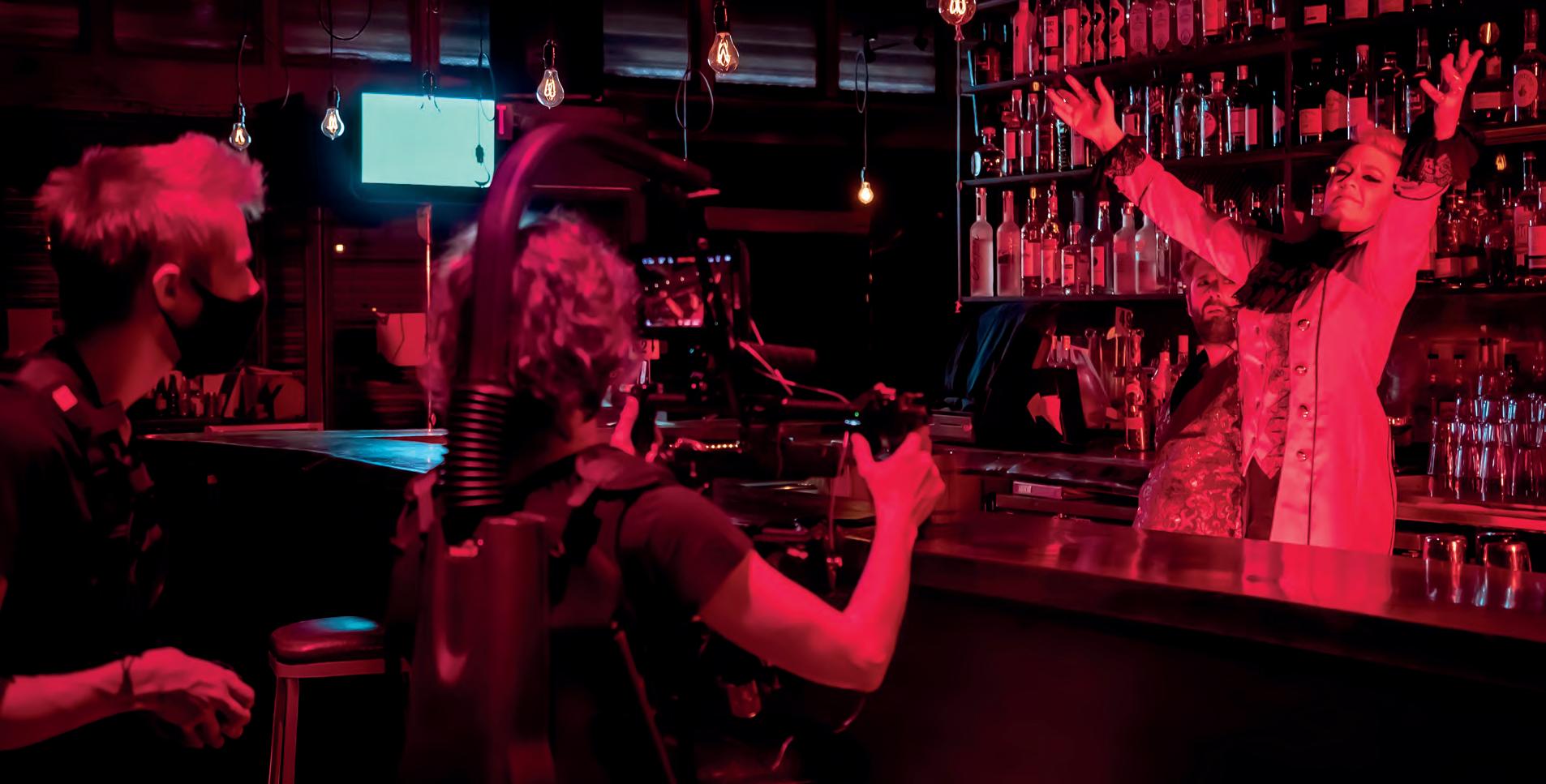
Headquartered just outside Madison, Wisconsin, the company was originally founded in 1975 after Fred Foster and his brother Bill, together with Gary Bewick and James Bradley, developed the groundbreaking Mega Cue lighting-control console for theatres out of their parent’s garage. Fred went on to take on many roles in the burgeoning business – from original inventor/engineer to industrial designer, tech support, salesman, marketer, chief operating officer, to president, and finally, CEO. With this leadership, the company has consistently been a pioneer in the field of lighting, originally for theatre and now also for TV and film studios.
Wide product gamut The ETC product range is broad, but cinematographers will know the company from its signature fixtures – to date over three and a half million Source Four fixtures have been made and sold.
“The Source Four has been very popular in studio environments, but it’s not a traditional style of studio lighting,” says Jim Uphoff, marketing product manager for fixtures at ETC. “Normally you want big aperture softlights for shadowing purposes. But if you need a beam of light coming through a window, and you need to shutter-cut that into just the right size, so the light only goes through that area, or if you need to do a pattern projection, there’s no fixture better than the Source Four, or more recently the Source Four LED. Because they’re so bright and so controllable, you’ll see them placed on the studio floor, bouncing the light off of a card over the set and basically using that as a big reflective aperture.”
ETC got into the LED market with the acquisition of lighting innovator Selador in 2009. “The Selador product line produced a far superior quality of colour and light to anything that we had seen before in LEDs. They used a seven colour LED mix to closely replicate traditional sources like Tungsten,” says Uphoff. “By using seven different wavelengths of LED, it led to a much more controllable and tuneable beam of light, as well as a higher quality. That has grown over the last decade into the Desire line, Source Four LED, ColorSource, and Source 4WRD [retrofits], and then the fos/4 line, which we introduced last year.” Studio focus Whilst ETC is well-known for theatrical lighting, it has also been a name in studios for over 40 years, says Uphoff, “whether it’s been controls, dimming products, rigging products and now obviously our LED fixtures and networking systems.”
With LED, ETC was keen to address the problem studio s had with dimming traditional sources like incandescent, which causes colour temperature changes like red shift. “That’s not the case with LEDs,” Uphoff explains. “LEDs shouldn’t shift as they dim and therefore you can do a lot more with them quickly and easily, so it’s a great fit for studios.”
Research efforts were expanded in 2016, when Foster launched ETC’s internal Advance Research Group (ARG) to uncover new technologies and boost current product capabilities. The first target was the ideal LED array for camera use.
“At the end of that process, they made recommendations for new arrays of LED which is what we now see in the fos/4, which is the Lustr X8 array and the Daylight HDR array,” says Uphoff.
The Lustr X8 array includes a new deep red LED, at 660nm wavelength.
“The traditional 635nm red that everybody has always used lacks what we call ‘the tungsten tail’, that last little visible bit of light before you fall off into the infrared,” says Uphoff. “It’s an incredibly important part of the spectrum. This deep red is synonymous with a natural rendering of skin tones, as well as costumes and set pieces, to make them look more natural and healthy and vibrant. Deep red expanded the gamut, giving us colours we couldn’t use before. Also adding that deep red to existing colour temperatures of white or other colours puts wavelengths back into the light that renders subjects more naturally and healthy than they do without it.
“If the wavelength is not in the source, you’re not going to see it on whatever you’re lighting. The camera can only take in the data that is available at that moment. So by having a broader spectrum, when a colourist goes in to do their work, they have all the ingredients that they need to make the picture as best they can.”
Recent TV series to harness ETC kit include Euphoria, shot by DP Marcell Rév, with gaffer Danny Durr and lighting programmer Chris Pritzlaff, The Unicorn lit by DP Craig Kief, with gaffer Justin Stroh and programmer Dylan Rush, and Big Shot with DP Alison Kelly, chief lighting technician Eric Forand and programmer Pat Duffy. Cinematographer Danna Kinsky used fos/4s on the short film The Waltz With Modern Panic, as well as shooting music videos with the panels.
DNA of the company With a 24/7/365 worldwide customer support line, service is a big focus at ETC.
“A lot of our employees, including myself, come from theatrical or entertainment backgrounds,” says Uphoff, previously an audio technician on Broadway.“That understanding of how the industry works is in the DNA of ETC. We wanted to bring that heritage of customer support, and industry peopleworking for ETC, to the studio market.
“We also wanted to bring what we had learned about the quality of light, about LED colour mixing and colour control, which is key to turning this technology into usable tools,” he adds. “Artists are very adaptive, they will take whatever tool they can get and make it work. But there are certain considerations about the workflow, of the way things work on a set or in a soundstage, that make for a better product if they’re part of the initial design process. So we wanted to make a concerted effort to make tools specifically designed for the studio market using the things we learned about live entertainment technologies, and that’s what fos/4 is supposed to represent.”
According to Uphoff, this approach has led directly to key features of ETC’s latest fixture. “For example, people don’t always have a DMX console, so they’ll want to set a light level on the fixture, quickly make adjustments there and move on,” he says. “So we have wireless technologies and near-field communication (NFC) to be able to do contactless configuration of fixtures.
“We also have a brand new user interface, a colour screen with backlit encoders, where the colours of the encoders change corresponding to what’s on the screen. You can quickly learn how to manipulate the lights,” he continues. “But at the end of the day, it’s all about the light coming out of the front of the fixture. We wanted to wrap a package around our technologies that would be suitable for this environment.”
Not all LED fixtures are created equal. “We’ve seen LED products sold on the market today that have a similar, in some cases worse, lumens per watt than Source Four incandescent fixtures,” says Uphoff. “The assumption is if it’s LED, it’s an energyconscious green fixture. It’s not always the case.
“The quality of the design, the efficiency of the optical system, the efficiency of the array and the thermal management, the power supplies, all have an impact,” he continues. “We take a lot of time and care to pick the appropriate components to try to keep our fixtures as green as possible.”
A good example is the NFC chip in the fos/4. “The fixture doesn’t even need to be plugged in,” says Uphoff. “The chip uses the power of the wireless signal coming off your phone to store the data on its flash memory. The next time the fixture powersup, it pulls the data off of that chip and loads the configuration. A rental shop can factory default a case of fixtures without having to take them out.
“Packaging is a big environmental issue as well,” he continues. “Obviously we have to get our product to site in one piece, but we try to use recyclable materials, such as cardboard inserts and pressed pulp packaging as opposed to foam.”
Legacy Fred Foster, a humanitarian and community builder, as well as visionary engineer in the lighting world, sadly passed away in 2019 at the age of 61. His presence is still felt.
“We still have conversations all the time about what would Fred say, how would he handle a particular situation? His thumbprint is still all over the company,” says Uphoff. “We waited to get into LED, because Fred didn’t see it upholding the quality that was necessary for art – until he saw Selador. He felt he needed to protect artistry in the markets that we cater to. That legacy continues at ETC, advancing the way those people work while holding on to the traditions that have made their industries what they are.”
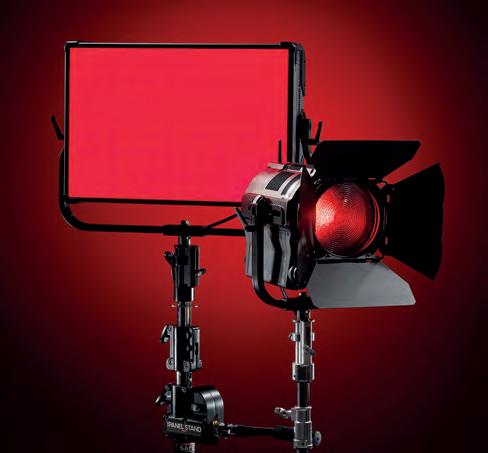
Main: Seeing red - Cinematographer Danna Kinsky filming The Waltz With Modern Panic Lower: ETC Fos4 Panel and right, Fos4 Fresnel







